In just about every way, last week’s reveal of Sidewalk Lab’s vision for Quayside, a 4.9-hectare swath of the eastern waterfront near the foot of Parliament, was a masterwork of spin, flattery, and urban myth-making.
The plan, a response from an Alphabet/Google subsidiary to a Waterfront Toronto RFP, is steeped in a cool, urban sensibility that seems perfectly calibrated to at least one strand of the city’s current notion of itself. The 196-page document meticulously name-checks virtually every project, aspirational plan and policy preoccupation circulating in the region right now, all of it packaged in the hip branding of sustainability, complete communities and inclusiveness.
Yet Sidewalk’s rhetoric, like all such documents, not only flatters and refracts but entices with solutions that, it claims, are not currently on offer but could be, given the right confection of will, resources and imagination. Toronto, it says, has an opportunity to rocket to the very coal face of urban thinking, planning and building.
Thus packaged and marketed, it’s absolutely no surprise that Sidewalk’s pitch was met last week with an almost entirely uncritical media response that reverberated far beyond the echo chamber of our self-involved civic conversation.
I don’t buy it.
What I’d like to argue, instead, is that this proposal actually deserves intense political and civic scrutiny – much more than Waterfront Toronto provided, unfortunately.
To my eye, Alphabet has proposed a model (“platform”) of urban development that could be described as a built form version of Facebook – a highly enticing but heavily surveilled environment literally programmed to capture and sell user information to marketers, technology companies and whoever else can figure out how to monetize the way we live in and move around urban spaces.
Indeed, Alphabet/Sidewalk clearly regards Toronto’s waterfront – not just Quayside, but the Portlands as well — as a massive research and development incubator for future product development. In other words, a means to an end.
And after two decades of waterfront revitalization that has begun to deliver great results, my question is whether this is the future we signed up for.
Here are some details that caught my attention:
Scale: While WT’s RFP called for proposals for Quayside, Sidewalk evidently has a much larger canvas in mind. The document has no fewer than 270 mentions of “Eastern Waterfront,” by which it means the Portlands. Senior City planning officials told me that they regard the proposal as a “commercial” initiative for this particular area, but the Sidewalk’s ambitions extend way beyond that tight L-shaped space.
And not just geographically. The document espouses changes in transit governance, health care delivery, and other domains. It also proposes dramatic changes to the land-use and zoning process, recommending an “outcomes” based approach that would somehow allow developers to get fast-track approvals by submitting data and other analytics that somehow predict the impact of their project (emissions, traffic, etc.). It may be a good idea; I can’t really tell based on the general information provided. But in the context of this proposal, Sidewalk’s messaging is clear: we’ll need the runway to be as clear as possible to get this thing going.
Surveillance of Public Space. I know even as I type the word that I am raising everyone’s hackles, but key to the whole plan is a deployment of an extensive network of sensors and other network technologies that are designed to quantify the way people use this new community. Don’t be misled by the fact that the proposal assures readers that former Ontario privacy commissioner Anne Cavoukian has been recruited to ensure that privacy is protected; the point of the project isn’t individual surveillance but aggregated and then segmented data tracking movement and usage of all sorts.
I’m not fussed about the vehicle counts or sensors that gauge and assess how much waste material is going into Sidewalk’s high-tech recycling systems. But there are other elements in this plan that are potentially far more troubling. For example, sensors on street furniture (are we going to monitor how well a bench is used?) or inducements for residents and visitors (yes) to sign in to a purpose-built Quayside network that makes it easier for them to communicate.
Easier than, say, texting?
What’s the point of a feature like this? I’m guessing it is about capturing aggregated data on the movement and activities of people traveling through this space. Sidewalk’s proposal is fairly explicit about this point. The company wants to use the enticement of Google Canada’s relocated headquarters and this new “platform” community as a means of attracting tech companies that could fashion and beta-test services – e.g., a mapping app that allows you to avoid crowds. In the logic of a vast enterprise that sees the world as reducable to analyzable data, I can see the appeal.
But let’s not sugarcoat what’s being proposed, which is the commodification of living in and moving through urban space — something that only becomes possible if the traces of said movements can be captured and processed.
Flexibility: This is other word that shows up extensively in the Sidewalk proposal. Everything about this scheme is meant to be flexible: the housing, the retail, the services, even the cultural venues and institutional buildings. The plan, dare I say, is rigid in its conviction that “radical flexibility” is the hallmark of the future city.
Across history, of course, cities have proven to be complex organisms capable of tremendous flexibility and organic change. But there’s a big difference between flexible and provisional. I’m not interested in provisional urban spaces filled with placeholders; that’s not city building. Yes, let’s think about designing affordable housing and offices that can be adapted and retrofitted as the needs of the occupants change. Yet I feel suspicious of an urban planning paradigm that makes such a point of foregrounding flexibility, because it suggests a trial-and-error approach that re-confirms for me that Sidewalk’s development plan is an R&D lab, not a real community.
Economics: Sidewalk’s proposals for housing and sustainability are reminiscent of good ideas that are in extensive use in places like the Netherlands and Denmark – very limited private vehicle access, cutting edge green energy/cleantech infrastructure, modular, pre-fab architecture, etc. The added element is an extensive subterranean network of utility tunnels than not only serve as conduits for cables, pipes and pneumatic waste tubes, but doubles as an internal robot delivery system for cargo and all the quotidian stuff (groceries, the enormously heavy IKEA shelving unit) that’s too cumbersome for people to schlep from the car-share drop-off to their front door.
This is all pleasantly cool and Scandinavian, and Sidewalk, clearly alive to the city’s real estate prices, has made sure to foreground the importance of building affordable housing in its new community (as per WT’s requirements). What’s less clear is how the math works, especially in the context of a highly contaminated, land-filled setting where all those utility tunnels will need to be constructed beneath the water table. It all looks fairly expensive, especially if a portion of the housing is meant to be affordable. Someone’s going to have to pay, and the vision, which, to be fair, is not a business plan, offers very little clarity on this important detail.
If you step back, it’s certainly possible to situate Sidewalk’s plan in the long tradition of idealistic urban reform ideologies that were meant to address the social or economic failings of the city at particular moments in time: Ebenezer Howard’s late 19th century Garden City suburbs; the Levittown subdivisions of the post-war era; the New Urbanist enclaves of the 1990s, including Celebration, the fantasy town developed in Florida by Disney and meant to showcase nostalgic urban design principles.
In almost all cases, these experiments produced unintended consequences, and I have every confidence that the relentless data-fication of city living will produce so-called use cases that no one’s especially comfortable with.
But in some important ways, Sidewalk’s Alphabet City is a very au courant take on the old idea of the company town – the factory (Google Canada’s HQ) surrounded by purpose-built worker housing (let’s not kid ourselves: Sidewalk’s residential proposals laser target the tech workers it wants to attract) and enough commercial space to accommodate the spin-off businesses that spring up around the main plant.
A generation ago, Microsoft and Apple and all the other tech supernovas built soulless corporate campuses in desperately dull suburban settings that don’t stir the hearts of the new generation of software engineers and coders who populate these firms. Alphabet/Google not only learned that lesson, but has glommed onto the notion that the projected future of urban living — with its self-driving vehicles and pop-up shops — represents the commercial space it intends to inhabit or even dominate.
Put another way, will Toronto become Google’s version of Dearborn, Redmond, or Cupertino?
If that’s the path WT intends to pursue, I think the agency, the City, and Torontonians generally need to ask whether this is what we want from our waterfront, and whether the data-fication of city living is the wagon to which we intend to hitch our future. It may be, I don’t know. But now that Sidewalk’s proposal has landed, that is a conversation the city desperately needs to have with itself.

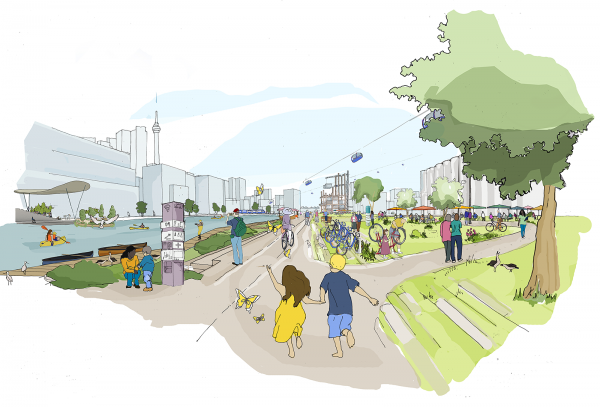

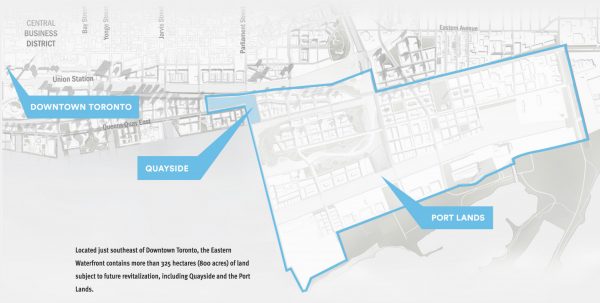
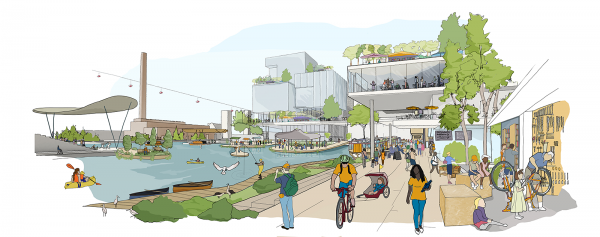
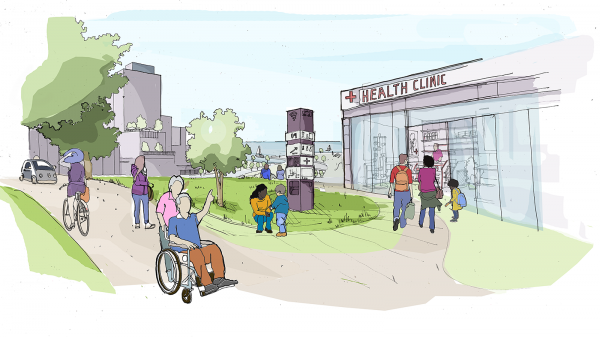
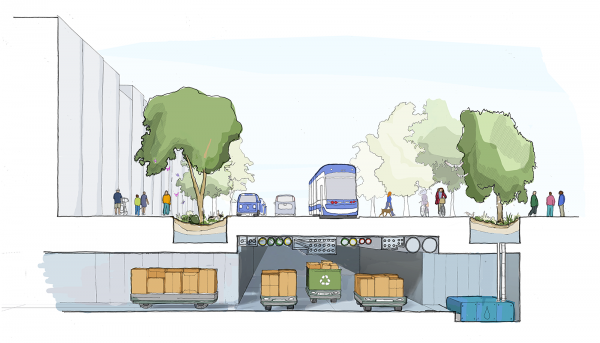
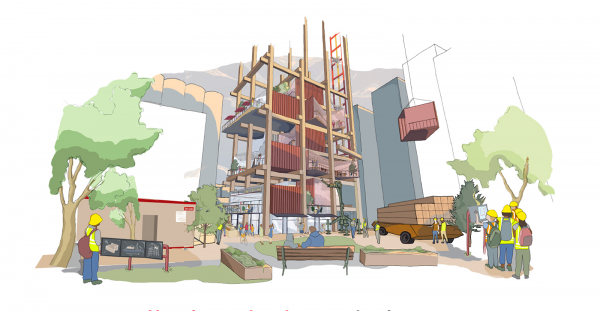



3 comments
Wonderful piece John. Thank you.
It took the Financial Times, not any Cdn media to report this:
Alphabet to build futuristic city in Toronto – Financial Times
[…]
In its proposal, Sidewalk also said that Toronto would need to waive or exempt many existing regulations in areas like building codes, transportation, and energy in order to build the city it envisioned. The project may need “substantial forbearances from existing laws and regulations,” the group said.
[…]
https://www.ft.com/content/5044ec1a-b35e-11e7-a398-73d59db9e399?mhq5j=e7
The Twilight Zone couldn’t beat this for a plot to “take over Humanity”.
And the UK Guardian has another excellent piece just up on this (their second) Other than Lorinc’s excellent piece, the Cdn press is wafting in the soma of gift horse farts.
Google wants to run your city. That’s not a world we should live in
Jathan Sadowski
A new initiative will see Alphabet – the parent company of Google – take charge of redeveloping a waterfront district in Toronto. Here’s why that’s troubling
https://www.theguardian.com/commentisfree/2017/oct/24/google-alphabet-sidewalk-labs-toronto